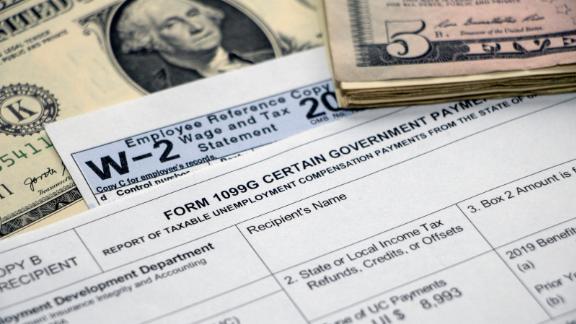
How to file for unemployment in 10 steps
(CNN) —
While unemployment has been inching downward in recent weeks, more than 23 million American workers are still currently receiving some form of government jobless benefits, and the official unemployment rate stands at 7.9% as of the end of September. Last week, over a million Americans filed an initial application for unemployment due to a new job loss or reduced hours.
But simply filing an unemployment claim doesn’t necessarily guarantee you’ll receive benefits. And even once you’ve gotten approved for unemployment, there are certain things you may need to do to keep it. It’s important to check the right boxes and do the required follow-up work to get the money that can help make ends meet, so follow these 10 steps to avoid any pitfalls.
In order to be eligible for unemployment benefits, you generally must have been laid off from your job, furloughed, had your hours reduced or been required to quarantine due to the coronavirus. You’re not eligible if you quit or were fired for cause — it has to be a lack of work that was out of your own control.
If you lost your job for another reason and file for unemployment anyway, your previous employer can challenge your claim, and you might be denied for benefits.
You also must have earned a minimum amount of wages as an employee to qualify for regular unemployment. However, the federal CARES Act passed in March expanded eligibility to gig workers, independent contractors and self-employed people. This part of the program is called Pandemic Unemployment Assistance, or PUA, but the basics are the same as regular unemployment insurance.
So if you were a ride-share driver but now can’t find work because everyone is staying at home, you can file a claim. However, because this is a brand-new expansion of unemployment eligibility, many states originally struggled to implement it. The situation has improved in recent months, but you should still be prepared for delays.
When you file, you’ll need to be ready to submit not only your own basic information — such as name, address, phone number, Social Security number and so on — but also where you were employed, your dates of employment and earnings info. If you’ve had more than one job in recent years, you’ll need the info for all of them.
“Making an accurate accounting of all income for every month for the last 18 months is important,” says Michele Evermore, senior researcher and policy analyst at the National Employment Law Project. “That will ensure that claimants can get the maximum benefit.”
Related: Lost your job? Take 30 minutes to reduce these three major household expenses.
If you’re a gig worker or independent contractor, you’ll need to prove your previous income to be eligible for the PUA program. That could be tricky if you’ve had irregular earnings.
“Some states base benefits on the highest quarter of income, which may be lost when a worker only has a 1099 for the whole year for proof of income,” explains Evermore. “Workers should come prepared with all of the ways that they know they have been paid to establish for themselves a good high quarter of earnings.”
While there are federal guidelines that govern unemployment eligibility, unemployment benefits are administered and paid out by your state. As a result, you’ll file for unemployment with one of 50 state agencies, not the federal government.
When you file for unemployment, it’s called filing a claim. To file an unemployment claim, you’ll need to call your state’s unemployment office, visit it in person or submit a claim online. That last option is almost certainly your best bet, if possible.
The US Department of Labor sponsors a website with a list of the online filing options for every state. To start filing a claim, choose your state from the drop-down menu and look for the link under the section titled “To file a UI claim online.”
Even with unemployment dropping in recent months, states are still inundated with claims, so even when you’re filing online, don’t be surprised if you encounter a problem or delay during at least one point in the process. You might try applying either early or late in the day — or even in the middle of the night if you’re awake — in order to get your claim through the system.

State unemployment websites are overwhelmed, so try to file when others aren’t.
PHOTO:
iStock
Some states are also asking certain groups to apply on certain days, such as Hawaii, which is requesting that people whose last names start with A through G file on Mondays, H through O on Tuesdays and P through Z on Wednesdays. You’ll need to check with your state to find out its specific rules.
That being said, if you’ve lost your job, make it a priority to file as quickly as you can, as waiting delays getting your claim approved. Unfortunately, there aren’t many tricks to getting through other than being persistent.
Not only does each state have its own unemployment rules, each state also pays out a different amount for unemployment.
In many states, you’ll get roughly half of what you earned at your job each week for up to 26 weeks. But other states have a different formula that’s less generous, so the overall average replacement rate is closer to 40%. And in some states, the benefits period can be as short as 12 weeks.
But as part of the same CARES Act that expanded eligibility, Congress also added an additional 13 weeks of unemployment funding. So right now, depending on your state, you might be eligible for up to 39 weeks of unemployment benefits.
Also, each state has a cap, or maximum amount, you can get, and that maximum amount varies significantly depending on where you live. According to figures provided by Evermore, the lowest is $235 in Mississippi, and the highest is in Massachusetts at $1,192, including additional dependent allowances.
So if you were lucky enough to have a well-paying job, you’ll probably get a lot less than half of your previous salary each week from your unemployment claim.
As part of the CARES Act, Congress originally provided an extra $600 per week that was added on top of state unemployment benefits. However, this $600 federal “add-on” expired at the end of July, and Congress and the White House haven’t been able to agree on an extension.
While negotiations are still ongoing for a second stimulus plan, even if one finally passes, there are no guarantees that it’ll include another federal addition to unemployment. So when you’re budgeting your expenses, plan on only having access to what your state provides. Then if a federal addition is eventually passed into law, it’ll be icing on the cake.
Do you have to pay taxes on your unemployment benefits? In a word, yes, at least when it comes to your federal income tax return. “Unemployment compensation is subject to income taxes but is not subject to Social Security and Medicare taxes,” says Kathy Pickering, H&R Block’s chief tax officer.
So unlike the $1,200 stimulus payment that many people received over the spring and summer, the federal government will tax your unemployment benefits. And it’s not just federal taxes, either: Thirty-four states fully tax unemployment benefits, and two states partially tax unemployment benefits, according to Pickering.

When tax time comes, you’ll receive a 1099-G form listing the unemployment benefits that are paid to you.
PHOTO:
iStock
You’ll need to include any unemployment payments you received in 2020 on your income tax return when you file it by April 2021. If you’re concerned about owing tax on that money, you can elect to pay it as you go so you don’t get hit with a bill next year.
“Many people find it easier to have taxes withheld from unemployment rather than make estimated tax payments,” explains Pickering. “Having taxes withheld or making estimated tax payments are both ways you can minimize the risk of an unexpected balance due and potential penalties.”
If you’ve filed your claim, gotten it approved and start receiving unemployment benefits, there are additional rules you need to be aware of to make sure you don’t lose your benefits before you get a new job.
Most states require people who are receiving unemployment benefits be not only willing to work but actively looking for work. That requirement was waived by essentially every state at the start of the pandemic, but a number of them have now reimposed it.
However, as we’ve noted many times, every state is different, and also the definitions of “actively looking for work” vary from state to state. So if you aren’t sure if your state requires you to be currently looking for work, or what you need to do to prove that you’re looking for work, double-check its unemployment website to find out.
While the additional 13 weeks of unemployment benefits being provided under the CARES Act will kick in automatically in some states, other states require that you apply separately for the extension. You’ll need to read the notices your state sends you to determine if you need to complete an additional application, or your payments could end up being interrupted.
Finally, what if your company has remained closed but finally reopens and calls you back to work? That means you have a current offer of employment and are no longer eligible to receive unemployment benefits.
Exceptions are available if you’ve been told by a health provider to quarantine, or if you’re caring for children while schools are closed. But remote schooling generally doesn’t count as a school being “closed” for unemployment purposes, though some child caregivers might be eligible for PUA or family leave benefits.
Being called back to work may be a difficult situation if you aren’t comfortable returning to work right now. Your best bet may be to discuss the situation with your boss to see if there are any accommodations that can be made, but don’t count on continuing to collect unemployment if your work returns.

If you’ve lost your job, file for unemployment — it’s there to help.
PHOTO:
iStock
No one likes losing a job, but don’t think of unemployment insurance as a crutch or something to be embarrassed about. The unemployment insurance system exists as a backstop for people to use when they need it, and it’s needed by people now more than ever.
So if you’ve lost your job or aren’t working as many hours as before, get an unemployment claim filed as quickly as you can and get a temporary income stream flowing back into your household.
Having money issues due to the coronavirus pandemic? Read CNN Underscored’s previous stories in this series:
















